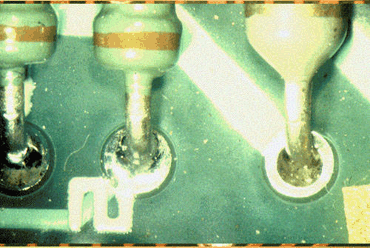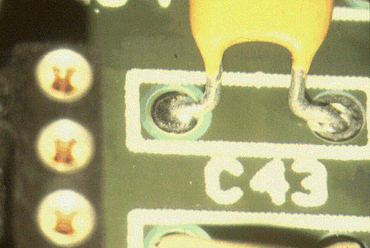Home > SMT Assembly News
For a solder joint to form on the topside of a board, flux needs to be present in the plated through holes. The temperature of the topside of the board needs to have reached a minimum of 100-110°C. The most common process problem today with no clean is limited flux application. It is generally uncommon to have problems with through hole plating provided a board manufacturer's products are evaluated prior to use. It is also firmly uncommon to have contamination in the through hole causing this sort of problem. If flux penetration is present and correct pre-heat obtained then have the printed board tested.

Figure 1: Poor penetration is caused by either inadequate flux application or inadequate pre-heating.
In Figure 2, the solder has failed to fill the plated through hole on one side of the component. The solder has wetted the PCB, but failed to fully wet the component lead, which is more likely to be flux related. If the fault is with the process conditions, there should be other positions on the board that have a similar problem. Simple solderability testing of the board and component termination should indicate if the fault is process or material related.

Figure 2: Poor penetration here is likely to be flux related.
Keywords:
SMT Reflow Oven, Lead free Reflow Oven, Reflow Oven Manufacturer, LED reflow oven, PCB Reflow Oven, Nitrogen Reflow Oven, Dual Rail Reflow Oven, China Reflow Oven, wave soldering machine, Dual Rail Wave Soldering Machine, Nitrogen Wave Soldering Machine, Wave Soldering Machine Manufacturer.
Flason Electronic Co.,ltd provide a full SMT assembly line solutions, including SMT Reflow Oven, Wave Soldering Machine, Pick and Place Machine, SMT Stencil Printer, SMT AOI SPI Machine, SMT Reflow Oven, SMT Peripheral Equipment, SMT Assembly line, SMT Spare Parts etc any kind SMT machines you may need, please contact us for more information: wechat whatsapp:+8613691605420, Skype: flasonsmt, Email: sales@flason-smt.com



Contact: Mr Tommy
Phone: +86 13691605420
Tel: +86 -755-85225569
Email: sales@flason-smt.com
Add: No.94,Guangtian Road,Songgang Street,Bao an District Shenzhen China